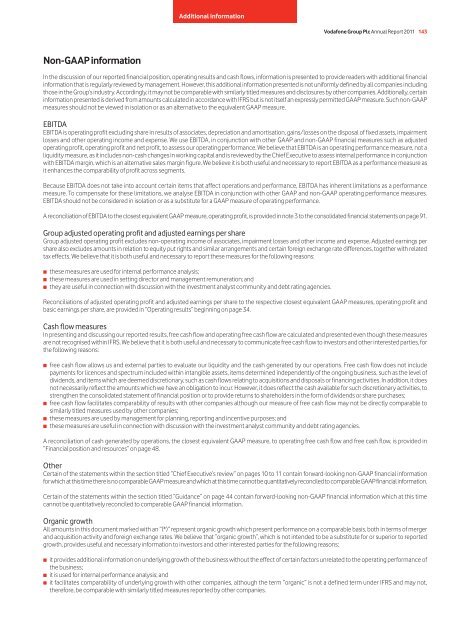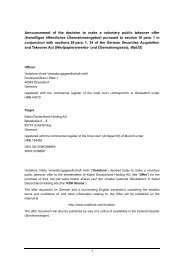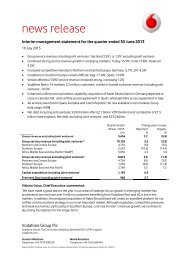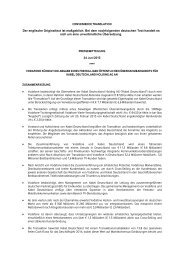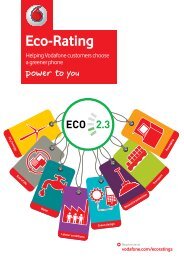Download the report - Vodafone
Download the report - Vodafone
Download the report - Vodafone
Create successful ePaper yourself
Turn your PDF publications into a flip-book with our unique Google optimized e-Paper software.
Non-GAAP information<br />
Additional information<br />
<strong>Vodafone</strong> Group Plc Annual Report 2011 143<br />
In <strong>the</strong> discussion of our <strong>report</strong>ed financial position, operating results and cash flows, information is presented to provide readers with additional financial<br />
information that is regularly reviewed by management. However, this additional information presented is not uniformly defined by all companies including<br />
those in <strong>the</strong> Group’s industry. Accordingly, it may not be comparable with similarly titled measures and disclosures by o<strong>the</strong>r companies. Additionally, certain<br />
information presented is derived from amounts calculated in accordance with IFRS but is not itself an expressly permitted GAAP measure. Such non-GAAP<br />
measures should not be viewed in isolation or as an alternative to <strong>the</strong> equivalent GAAP measure.<br />
EBITDA<br />
EBITDA is operating profit excluding share in results of associates, depreciation and amortisation, gains/losses on <strong>the</strong> disposal of fixed assets, impairment<br />
losses and o<strong>the</strong>r operating income and expense. We use EBITDA, in conjunction with o<strong>the</strong>r GAAP and non-GAAP financial measures such as adjusted<br />
operating profit, operating profit and net profit, to assess our operating performance. We believe that EBITDA is an operating performance measure, not a<br />
liquidity measure, as it includes non-cash changes in working capital and is reviewed by <strong>the</strong> Chief Executive to assess internal performance in conjunction<br />
with EBITDA margin, which is an alternative sales margin figure. We believe it is both useful and necessary to <strong>report</strong> EBITDA as a performance measure as<br />
it enhances <strong>the</strong> comparability of profit across segments.<br />
Because EBITDA does not take into account certain items that affect operations and performance, EBITDA has inherent limitations as a performance<br />
measure. To compensate for <strong>the</strong>se limitations, we analyse EBITDA in conjunction with o<strong>the</strong>r GAAP and non-GAAP operating performance measures.<br />
EBITDA should not be considered in isolation or as a substitute for a GAAP measure of operating performance.<br />
A reconciliation of EBITDA to <strong>the</strong> closest equivalent GAAP measure, operating profit, is provided in note 3 to <strong>the</strong> consolidated financial statements on page 91.<br />
Group adjusted operating profit and adjusted earnings per share<br />
Group adjusted operating profit excludes non-operating income of associates, impairment losses and o<strong>the</strong>r income and expense. Adjusted earnings per<br />
share also excludes amounts in relation to equity put rights and similar arrangements and certain foreign exchange rate differences, toge<strong>the</strong>r with related<br />
tax effects. We believe that it is both useful and necessary to <strong>report</strong> <strong>the</strong>se measures for <strong>the</strong> following reasons:<br />
■ <strong>the</strong>se measures are used for internal performance analysis;<br />
■ <strong>the</strong>se measures are used in setting director and management remuneration; and<br />
■ <strong>the</strong>y are useful in connection with discussion with <strong>the</strong> investment analyst community and debt rating agencies.<br />
Reconciliations of adjusted operating profit and adjusted earnings per share to <strong>the</strong> respective closest equivalent GAAP measures, operating profit and<br />
basic earnings per share, are provided in “Operating results” beginning on page 34.<br />
Cash flow measures<br />
In presenting and discussing our <strong>report</strong>ed results, free cash flow and operating free cash flow are calculated and presented even though <strong>the</strong>se measures<br />
are not recognised within IFRS. We believe that it is both useful and necessary to communicate free cash flow to investors and o<strong>the</strong>r interested parties, for<br />
<strong>the</strong> following reasons:<br />
■ free cash flow allows us and external parties to evaluate our liquidity and <strong>the</strong> cash generated by our operations. Free cash flow does not include<br />
payments for licences and spectrum included within intangible assets, items determined independently of <strong>the</strong> ongoing business, such as <strong>the</strong> level of<br />
dividends, and items which are deemed discretionary, such as cash flows relating to acquisitions and disposals or financing activities. In addition, it does<br />
not necessarily reflect <strong>the</strong> amounts which we have an obligation to incur. However, it does reflect <strong>the</strong> cash available for such discretionary activities, to<br />
streng<strong>the</strong>n <strong>the</strong> consolidated statement of financial position or to provide returns to shareholders in <strong>the</strong> form of dividends or share purchases;<br />
■ free cash flow facilitates comparability of results with o<strong>the</strong>r companies although our measure of free cash flow may not be directly comparable to<br />
similarly titled measures used by o<strong>the</strong>r companies;<br />
■ <strong>the</strong>se measures are used by management for planning, <strong>report</strong>ing and incentive purposes; and<br />
■ <strong>the</strong>se measures are useful in connection with discussion with <strong>the</strong> investment analyst community and debt rating agencies.<br />
A reconciliation of cash generated by operations, <strong>the</strong> closest equivalent GAAP measure, to operating free cash flow and free cash flow, is provided in<br />
“Financial position and resources” on page 48.<br />
O<strong>the</strong>r<br />
Certain of <strong>the</strong> statements within <strong>the</strong> section titled “Chief Executive’s review” on pages 10 to 11 contain forward-looking non-GAAP financial information<br />
for which at this time <strong>the</strong>re is no comparable GAAP measure and which at this time cannot be quantitatively reconciled to comparable GAAP financial information.<br />
Certain of <strong>the</strong> statements within <strong>the</strong> section titled “Guidance” on page 44 contain forward-looking non-GAAP financial information which at this time<br />
cannot be quantitatively reconciled to comparable GAAP financial information.<br />
Organic growth<br />
All amounts in this document marked with an “(*)” represent organic growth which present performance on a comparable basis, both in terms of merger<br />
and acquisition activity and foreign exchange rates. We believe that “organic growth”, which is not intended to be a substitute for or superior to <strong>report</strong>ed<br />
growth, provides useful and necessary information to investors and o<strong>the</strong>r interested parties for <strong>the</strong> following reasons:<br />
■ it provides additional information on underlying growth of <strong>the</strong> business without <strong>the</strong> effect of certain factors unrelated to <strong>the</strong> operating performance of<br />
<strong>the</strong> business;<br />
■ it is used for internal performance analysis; and<br />
■ it facilitates comparability of underlying growth with o<strong>the</strong>r companies, although <strong>the</strong> term “organic” is not a defined term under IFRS and may not,<br />
<strong>the</strong>refore, be comparable with similarly titled measures <strong>report</strong>ed by o<strong>the</strong>r companies.


